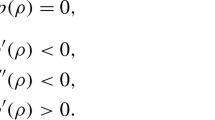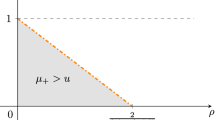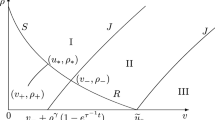Abstract
A traffic flow model is established based on the “car following” principle with a maximal constraint on the density–velocity relationship. The model develops the Aw–Rascle model and amends some “nonphysical” features. Moreover, we construct the solutions of the Riemann problem for the model. The Riemann solutions provide a more reasonable invariant region and show the phase-transition phenomena.

















Similar content being viewed by others
References
Aw A, Rascle M (2000) Resurrection of “second order” models of traffic flow. SIAM J Appl Math 60(3):916–938
Aw A, Klar A, Materne T, Rascle M (2002) Derivation of continuum traffic flow models from microscopic follow-the-leader models. SIAM J Appl Math 63(1):259–278
Gazis C, Edie C (1968) Traffic flow theory. Proc IEEE 56(4):458–471
Immers LH, Logghe S (2002) Traffic flow theory, vol 40. Faculty of Engineering, Department of Civil Engineering, Section Traffic and Infrastructure, Kasteelpark Arenberg
Berthelin F, Degond P, Delitala M, Rascle M (2008) A model for the formation and evolution of traffic jams. Arch Ration Mech Anal 187(2):185–220
Berthelin F, Degond P, Blanc V (2008) A traffic-flow model with constraints for the modeling of traffic jams. Math Models Methods Appl Sci 18(supp01):1269–1298
Kerner BS, Rehborn H (1997) Experimental properties of phase transitions in traffic flow. Phys Rev Lett 79(20):4030–4033
Kerner BS (2000) Phase transitions in traffic flow. Springer, Berlin
Payne HJ (1971) Models of freeway traffic and control, Mathematical models of public systems
Daganzo F (1995) Requiem for second-order fluid approximations of traffic flow. Transport Res B Methodol 29(4):277–286
Degond P, Delitala M (2008) Modelling and simulation of vehicular traffic jam formation. Kinet Relat Models 1(2):279–293
Bellomo N, Dogbe C (2011) On the modeling of traffic and crowds: a survey of models, speculations, and perspectives. SIAM Rev 53(3):409–463
Sun M (2009) Interactions of elementary waves for the Aw–Rascle model. SIAM J Appl Math 69(6):1542–1558
Tveito A, Winther R (1991) Existence, uniqueness, and continuous dependence for a system of hyperbolic conservation laws modeling polymer flooding. SIAM J Appl Math 22(4):905–933
Godvik M, HancheOlsen H (2008) Existence of solutions for the Aw–Rascle traffic flow model with vacuum. J Hyperbol Differ Eq 5(01):45–63
Herty M, Rascle M (2006) Coupling conditions for a class of second-order models for traffic flow. SIAM J Appl Math 38(2):595–616
Gerlough L, Huber J (1975) Traffic flow theory, Special Report 165, Transportation Research Board, National Research Council, Washington, DC
Zhang HM (2002) A non-equilibrium traffic model devoid of gas-like behavior. Transport. Res. B-Meth. 36(3):275–290
Bellomo N, Bellouquid A, Nieto J, Soler J (2014) On the multiscale modeling of vehicular traffic: from kinetic to hydrodynamics. Discrete Contin Dyn Syst Series B 19(7):1869–1888
Smoller J (1983) Shock waves and reaction–diffusion equations. Springer, New York
Freisthler H (1992) Dynamical stability and vanishing viscosity: a case study of a non-strictly hyperbolic system. Commun Pur Appl Math 45(5):561–582
Bellouquid A, De Angelis E, Fermo L (2012) Towards the modeling of vehicular traffic as a complex system: a kinetic theory approach. Math Models Methods Appl Sci 22(supp01):1140003
Dolfin M (2012) From vehicle–driver behaviors to first order traffic flow macroscopic models. Appl Math Lett 25(12):2162–2167
Xiao L, Tong Z (1978) The Riemann problem of non-convex Quasilinear hyperbolic systems. Chin Sci Bull 8:003
Acknowledgments
Supported by the National Natural Science Foundation of China (11171340).
Author information
Authors and Affiliations
Corresponding author
Rights and permissions
About this article
Cite this article
Jiang, WF., Wang, Z. Developing an Aw–Rascle model of traffic flow. J Eng Math 97, 135–146 (2016). https://doi.org/10.1007/s10665-015-9801-2
Received:
Accepted:
Published:
Issue Date:
DOI: https://doi.org/10.1007/s10665-015-9801-2




